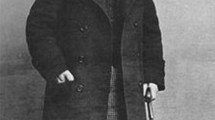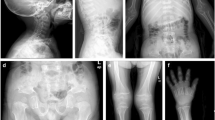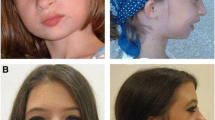Abstract
Dyggve-Melchior-Clausen syndrome is a rare autosomal-recessive disorder, characterized by progressive spondylo-epi-metaphyseal dysplasia associated with mental retardation. The clinical and radiological findings resembles Morquio disease at the onset of condition, which may hinder its diagnosis. Two siblings with chatacteristic clinical (progressive postnatal dwarfism and mental retardation) and radiological features (irregular lace-like appearance of the iliac crests) are reported.
Similar content being viewed by others
References
El Ghouzzi V, Dagoneau N, Kinning E, Thauvin-Robinet C, Chemaitilly W, Prost-Squarcioni C, et al. Mutations in a novel gene Dymeclin (FLJ20071) are responsible for Dyggve — Melchior — Clausen syndrome. Hum Mol Gene 2003; 12: 357–364.
Rodríguez Rodríguez CM, Pineda Marfa M, Duque R, Cormier-Daire V. Dyggve-Melchior-Clausen syndrome, diagnostic difficulty due to it similarity to Morquio disease. Neurologia 2007; 22: 126–129.
Burns C, Powell BR, Hsia YE, Reinker K. Dyggve-Melchior-Clausen syndrome: report of seven patients with the Smith-McCort variant and review of the literature. J Pediatr Orthop 2003; 23: 88–93
Kandziora F, Neumann L, Schnake KJ, Khodadadyan-Klostermann C, Rehart S, Haas NP, et al. Atlantoaxial instability in Dyggve-Melchior-Clausen syndrome. Case report and review of the literature. J Neurosurg 2002; 96: 112–117.
Horton WA, Hecht JT. Disorders involving cartilage matrix protiens. In: Kliegman RM, Jenson HB, Behrman RE, Stanton BF, editors. Nelson Textbook of Pediatrics, 18th ed. Philadelphia: Saunders-Elsevier Publisher; 2007. p. 2873–2877.
Toledo SP, Saldanha PH, Lamego C, Mourao PA, Dietrich CP, Mattar E. Dyggve-Melchior-Clausen syndrome: genetic studies and report of affected sibs. Am J Med Genet 1979; 4: 255–261.
Beighton P. Dyggve — Melchior-Clausen syndrome. J Med Genet 1990; 27: 512–515.
Spranger J, Maroteaux P, Der Kaloustian VM. The Dyggve-Melchior-Clausen syndrome. Radiology 1975; 114: 415–421.
Fielder J, Frances AM, Le Merrer M, Richter M, Brenner RE. X-linked spondyloepiphyseal dysplasia tarda: molecular cause of a heritable platyspodyly. Spine 2003; 28: E478–482.
Krakow D, Vriens J, Camacho N, Luong P, Deixler H, Funari TL, et al. Mutations in the gene encoding the calcium permeable ion channel TRPV4 produce spondylometaphyseal dysplasia, Kozlowski type and metatropic dysplasia. Am J Hum Genet 2009; 84: 307–315.
Author information
Authors and Affiliations
Corresponding author
Rights and permissions
About this article
Cite this article
Gupta, V., Kohli, A. & Dewan, V. Dyggve-Melchior-Clausen syndrome. Indian Pediatr 47, 973–975 (2010). https://doi.org/10.1007/s13312-010-0151-x
Received:
Revised:
Accepted:
Published:
Issue Date:
DOI: https://doi.org/10.1007/s13312-010-0151-x




